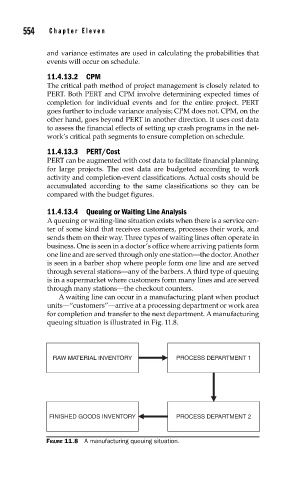Page 601 - Sensors and Control Systems in Manufacturing
P. 601
554
Cha p te r
Ele v e n
and variance estimates are used in calculating the probabilities that
events will occur on schedule.
11.4.13.2 CPM
The critical path method of project management is closely related to
PERT. Both PERT and CPM involve determining expected times of
completion for individual events and for the entire project. PERT
goes further to include variance analysis; CPM does not. CPM, on the
other hand, goes beyond PERT in another direction. It uses cost data
to assess the financial effects of setting up crash programs in the net-
work’s critical path segments to ensure completion on schedule.
11.4.13.3 PERT/Cost
PERT can be augmented with cost data to facilitate financial planning
for large projects. The cost data are budgeted according to work
activity and completion-event classifications. Actual costs should be
accumulated according to the same classifications so they can be
compared with the budget figures.
11.4.13.4 Queuing or Waiting Line Analysis
A queuing or waiting-line situation exists when there is a service cen-
ter of some kind that receives customers, processes their work, and
sends them on their way. Three types of waiting lines often operate in
business. One is seen in a doctor’s office where arriving patients form
one line and are served through only one station—the doctor. Another
is seen in a barber shop where people form one line and are served
through several stations—any of the barbers. A third type of queuing
is in a supermarket where customers form many lines and are served
through many stations—the checkout counters.
A waiting line can occur in a manufacturing plant when product
units—“customers”—arrive at a processing department or work area
for completion and transfer to the next department. A manufacturing
queuing situation is illustrated in Fig. 11.8.
RAW MATERIAL INVENTORY PROCESS DEPARTMENT 1
FINISHED GOODS INVENTORY PROCESS DEPARTMENT 2
FIGURE 11.8 A manufacturing queuing situation.

